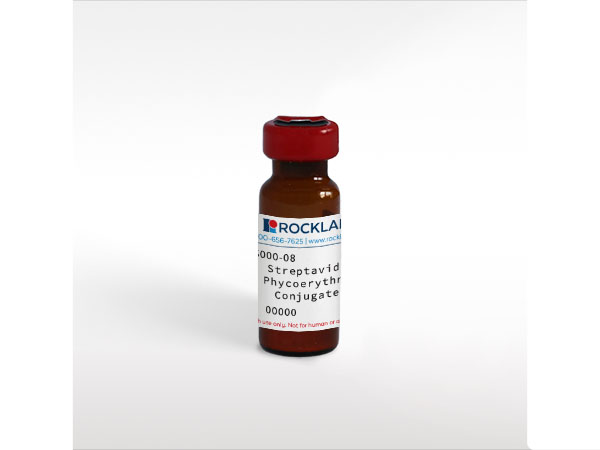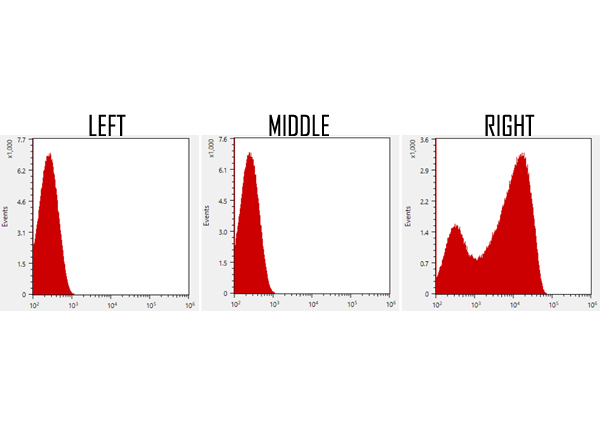Datasheet is currently unavailable. Try again or CONTACT US
Streptavidin Phycoerythrin Conjugated
7 References
S000-08
1 mL
Lyophilized
ELISA, IF, FC, Dot Blot, Multiplex, Biochemical Assay, Functional Assay
Shipping info:
$50.00 to US & $70.00 to Canada for most products. Final costs are calculated at checkout.
Product Details
Streptavidin Phycoerythrin Conjugated - S000-08
Streptavidin PE, Phyco Streptavidin, SA Phycoerythrin, R-Phycoerythrin, Phycoerythrin conjugated streptavidin
R-Phycoerythrin (RPE)
Target Details
Streptavidin-Phycoerythrin was prepared from electrophoretically purified streptavidin isolated from Streptomyces avidinii conjugated to the chromophore R-Phycoerythrin. Free fluorochrome is removed by tandem molecular sieve chromatography.
P22629 - UniProtKB
CAA00084.1 - NCBI Protein
Application Details
Dot Blot, FC, Multiplex
Biochemical Assay, ELISA, Functional Assay, IF
- View References
Phycoerythrin conjugated streptavidin has been tested by dot blot and FACS and is suitable for immunomicroscopy, flow cytometry or FACS analysis, as well as other antibody based fluorescent assays requiring extremely low background levels, absence of F(c) mediated binding, lot-to-lot consistency, high titer and specificity. The maximum amount of Streptavidin Phycoerythrin required to stain 1 x 10E6 cells in flow cytometry is approximately 1.0 µg of antibody conjugate. Lesser amounts of Streptavidin Phycoerythrin may be sufficient for staining. Optimal titers for other applications should be determined by the researcher. As a general guideline dilutions of 1:100 to 1:250 should be suitable for most applications.
Formulation
0.5 mg/mL by absorbance = 82.0 at 565 nm
0.02 M Potassium Phosphate, 0.15 M Sodium Chloride, pH 7.2
0.01% (w/v) Sodium Azide
10 mg/mL Bovine Serum Albumin (BSA) - Immunoglobulin and Protease free
1.0 mL
Restore with deionized water (or equivalent)
Shipping & Handling
Ambient
Store vial at 4° C prior to restoration. Restore with deionized water (or equivalent). This product is stable at 4° C as an undiluted liquid. Dilute only prior to immediate use. Centrifuge product if not completely clear after standing at room temperature. Do not freeze after reconstitution. Store reagent in the dark. Use subdued lighting during handling and incubation of cells prior to analysis.
Expiration date is one (1) year from date of receipt.
Streptavidin is a bacterial protein (from Streptomyces avidinii) that has an exceptionally high binding affinity for biotin (B7). Streptavidin-biotin binding is one of the strongest known non-covalent interactions and is highly resistant to many conditions that would typically cause dissociation (such as organic solvents, denaturants, detergents, and extreme temperatures or pH). Streptavidin's affinity for biotin can be employed in a variety of experimental uses, from purifications to standards, to means of detection or pull down experiments. Phycoerythrin (PE) is a red-pigmented protein found in cyanobacteria and red algae. Phycoerythrin absorbs light blue-green/yellow light and emits lightly orange/yellow light.
Poltavets, V et al. (2021). CXCR4-CCR7 Heterodimerization Is a Driver of Breast Cancer Progression. Life (Basel, Switzerland)
Applications
FC, FACS, FLOW
Felber BK. et al. (2020). Co-immunization of DNA and Protein in the Same Anatomical Sites Induces Superior Protective Immune Responses against SHIV Challenge. Cell Rep.
Applications
E, EIA; In Vitro Binding Assay
Miller, DC et al. (2016). The CII-specific autoimmune T-cell response develops in the presence of FTY720 but is regulated by enhanced Treg cells that inhibit the development of autoimmune arthritis. Arthritis Research & Therapy
Applications
FC, FACS, FLOW
Howe, R et al. (2009). Evidence for dendritic cell-dependent CD4(+) T helper-1 type responses to commensal bacteria in normal human intestinal lamina propria. Clinical Immunology (Orlando, Fla.)
Applications
FC, FACS, FLOW
Huang L et al. (2006). Identification and characterization of a human monoclonal antagonistic antibody AL‐57 that preferentially binds the high‐affinity form of lymphocyte function-associated antigen-1. J Leukoc Biol.
Applications
Cellular assay
Samy, ET. et al. (2005). Continuous control of autoimmune disease by antigen-dependent polyclonal CD4+CD25+ regulatory T cells in the regional lymph node. The Journal of Experimental Medicine
Applications
IF, Confocal Microscopy
Ruiz, W. et al. (2005). Kinetics and isotype profile of antibody responses in rhesus macaques induced following vaccination with HPV 6, 11, 16 and 18 L1-virus-like particles formulated with or without Merck aluminum adjuvant. Journal of Immune Based Therapies and Vaccines
Applications
Multiplex Assay
This product is for research use only and is not intended for therapeutic or diagnostic applications. Please contact a technical service representative for more information. All products of animal origin manufactured by Rockland Immunochemicals are derived from starting materials of North American origin. Collection was performed in United States Department of Agriculture (USDA) inspected facilities and all materials have been inspected and certified to be free of disease and suitable for exportation. All properties listed are typical characteristics and are not specifications. All suggestions and data are offered in good faith but without guarantee as conditions and methods of use of our products are beyond our control. All claims must be made within 30 days following the date of delivery. The prospective user must determine the suitability of our materials before adopting them on a commercial scale. Suggested uses of our products are not recommendations to use our products in violation of any patent or as a license under any patent of Rockland Immunochemicals, Inc. If you require a commercial license to use this material and do not have one, then return this material, unopened to: Rockland Inc., P.O. BOX 5199, Limerick, Pennsylvania, USA.










